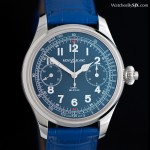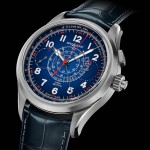Up Close: Montblanc 1858 The Unveiled Secret Minerva Monopusher Chronograph
Inverting the movement to showcase all that fine finishing.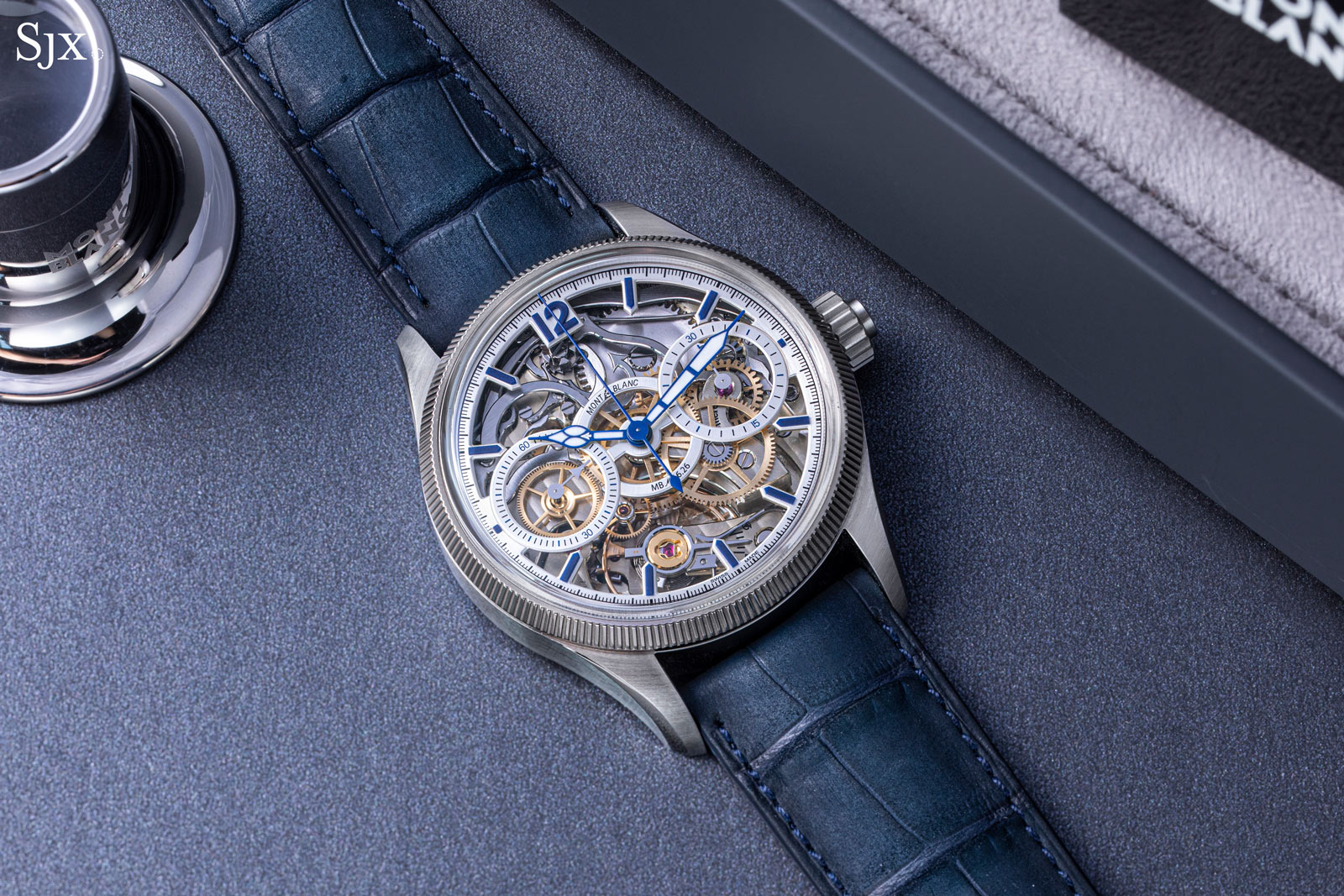
The latest offering in Montblanc’s high-end chronograph lineup is the 1858 The Unveiled Secret Minerva Monopusher Chronograph. In many ways it looks and feels like the Minerva chronographs that came before it. The case remains extra-large because of the pocket watch movement within and it still has a fluted bezel along with cathedral hands.
But the Unveiled Secret is totally different from its predecessors, as its movement has been inverted in order to bring the most interesting bits to the front. That required some mechanical rearrangement to accomplish, but manages to realise the desire often expressed by collectors who want to wear a watch with the finely finished movement showcased on the dial.
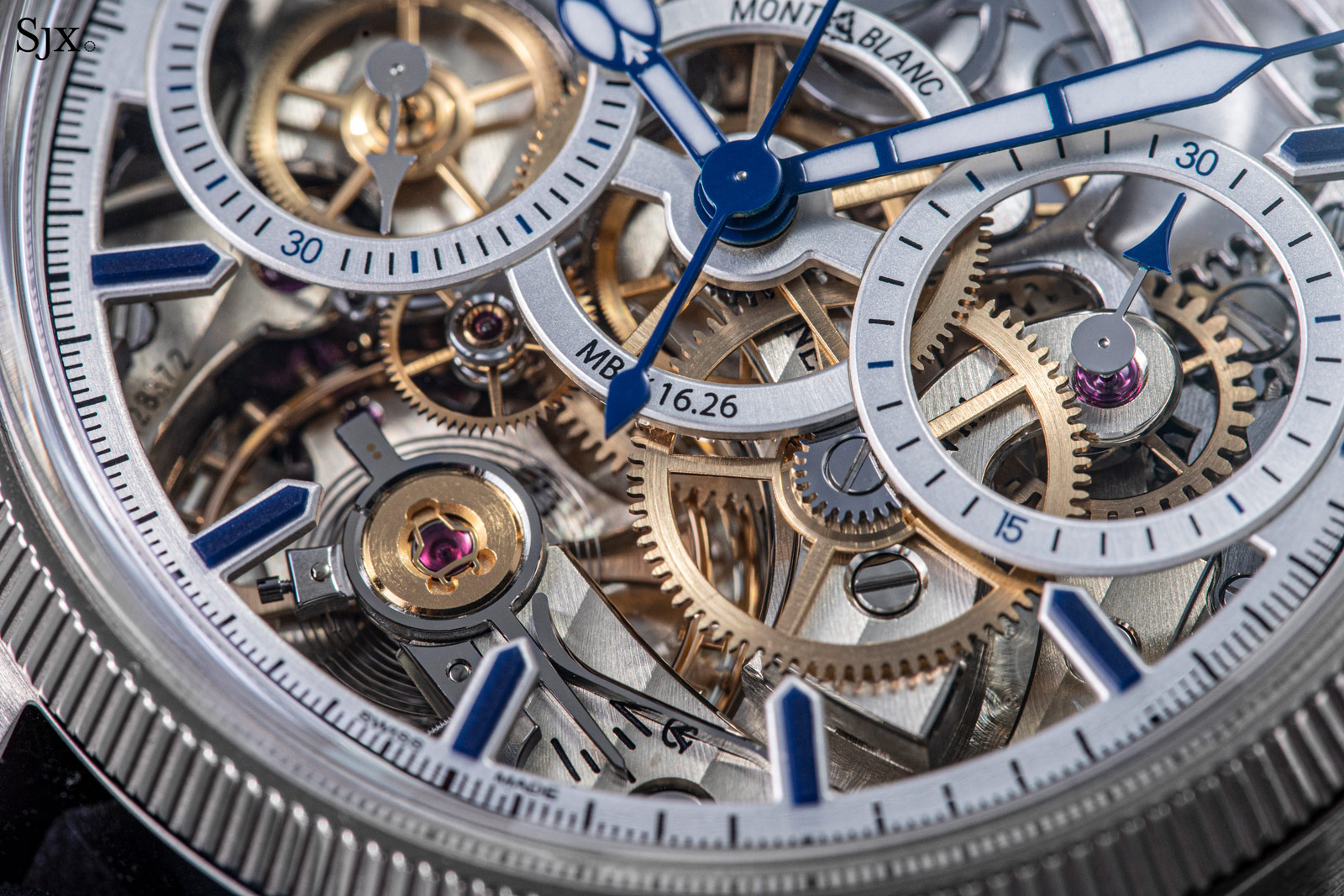
Initial thoughts
Hand-wind chronographs have been a specialty of Montblanc, at least for its high-end models, since it acquired Minerva several years ago. Minerva came along with its stable of historical chronograph movements, all traditionally constructed in an elegant, delicate manner, albeit in a slightly anachronistic manner since the calibres mostly dated to the early-20th century. As a result, Montblanc can count several impressive chronographs in its collection, but the Unveiled Secret does it differently.
Though the inversion trick has been done before by other hands, the Unveiled Secret is still a little more creative and a little more interesting. It relies on a simple trick: the hands are mounted on what is ordinarily the back of the movement, while the entire movement is flipped so that the hands are now on the front. Meanwhile what is usually the “dial side” of the movement is now hidden under a closed case back.
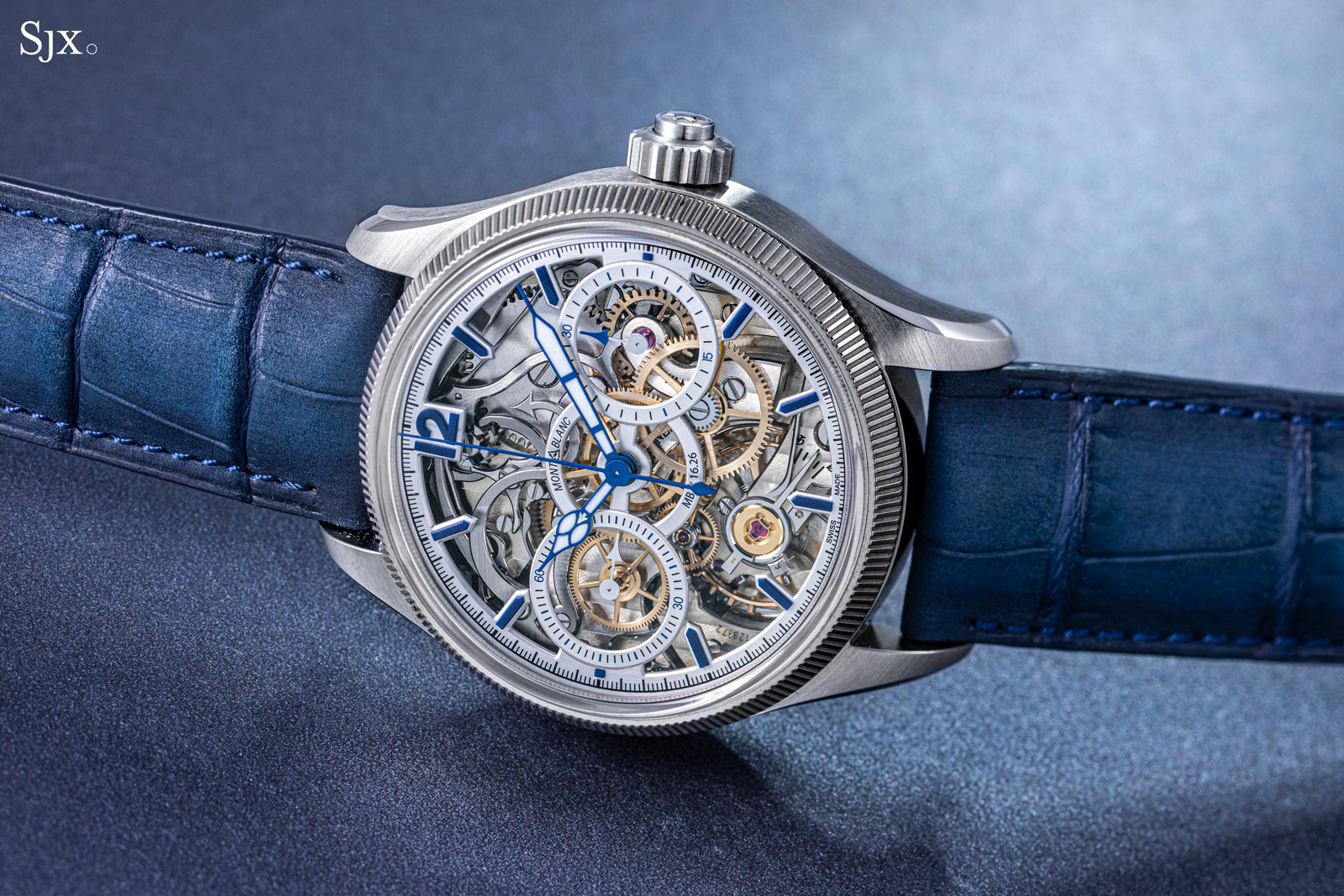
Importantly, it should be noted that the Unveiled Secret is an integrated chronograph, so it is a bona fide inverted movement. The calibre inside started out as the conventional MB 16.29, before being modified to flip the movement and invert the time display. That contrasts with modular chronographs that reveal their mechanics on the dial, such as the Hublot Big Bang Integral and Czapek Antarctique Rattrapante. The Unveiled Secret is certainly more impressive in its design and construction, making it more appealing than its modular equivalents.
With both the hands and chronograph mechanism now on the dial, the Unveiled Secret should be a showcase of all the mechanics that lie behind them, at least in theory. And there is a lot to admire, most notably with the slender chronograph levers under 12 o’clock and the large balance wheel located at seven o’clock.
That said, the chronograph mechanism isn’t that apparent as the sub-dial rings and wheel train for the hands get in the way. That’s pretty much unavoidable since the rings are needed to use the chronograph while the additional wheels were necessary to relocate the hands to the movement side.
At the same time, the rings for the time and registers are not executed as well as the movement. That difference in quality is faintly visible on the wrist, but not a deal breaker. The movement remains top notch, and there is enough to admire that the Unveiled Secret over-delivers in terms of a dial teeming with finely finished mechanics.
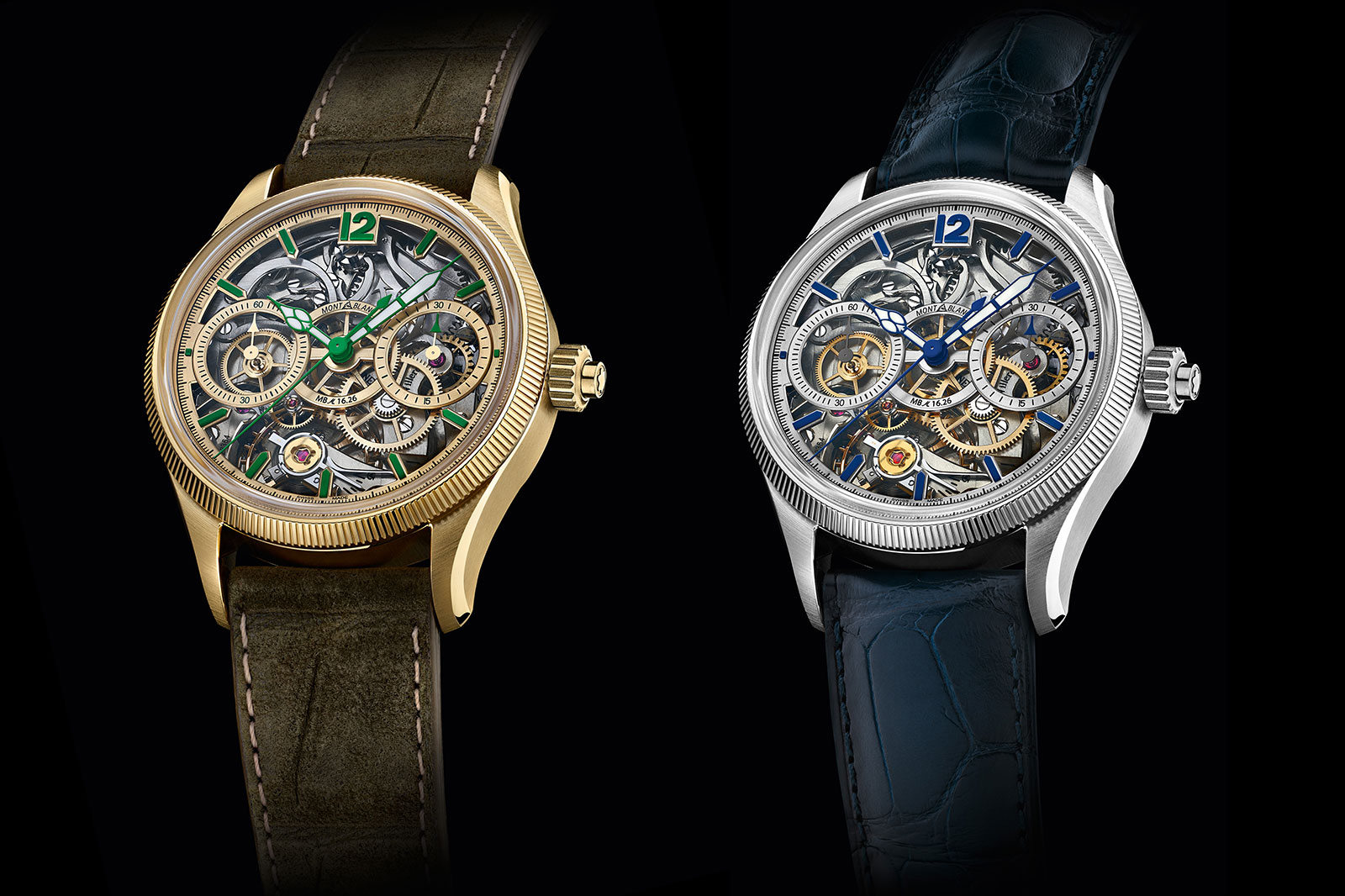
The Unveiled Secret is available in Lime Gold (left) and steel. The rings for the sub-dials are less obvious on the gold version, while the movement also has more contrast against the gold case and rings. Image – Montblanc
Priced at US$33,500 in steel and about 50% higher in gold, the Unveiled Secret is a pricey watch but still a value proposition all things considering. The movement is appealingly traditional and finished to a high level, making it amongst the best in its price range in that respect. Admittedly the movement has little by way of technical innovation since the original construction is decades old, but that doesn’t take away from its appeal and also the quality of decoration.
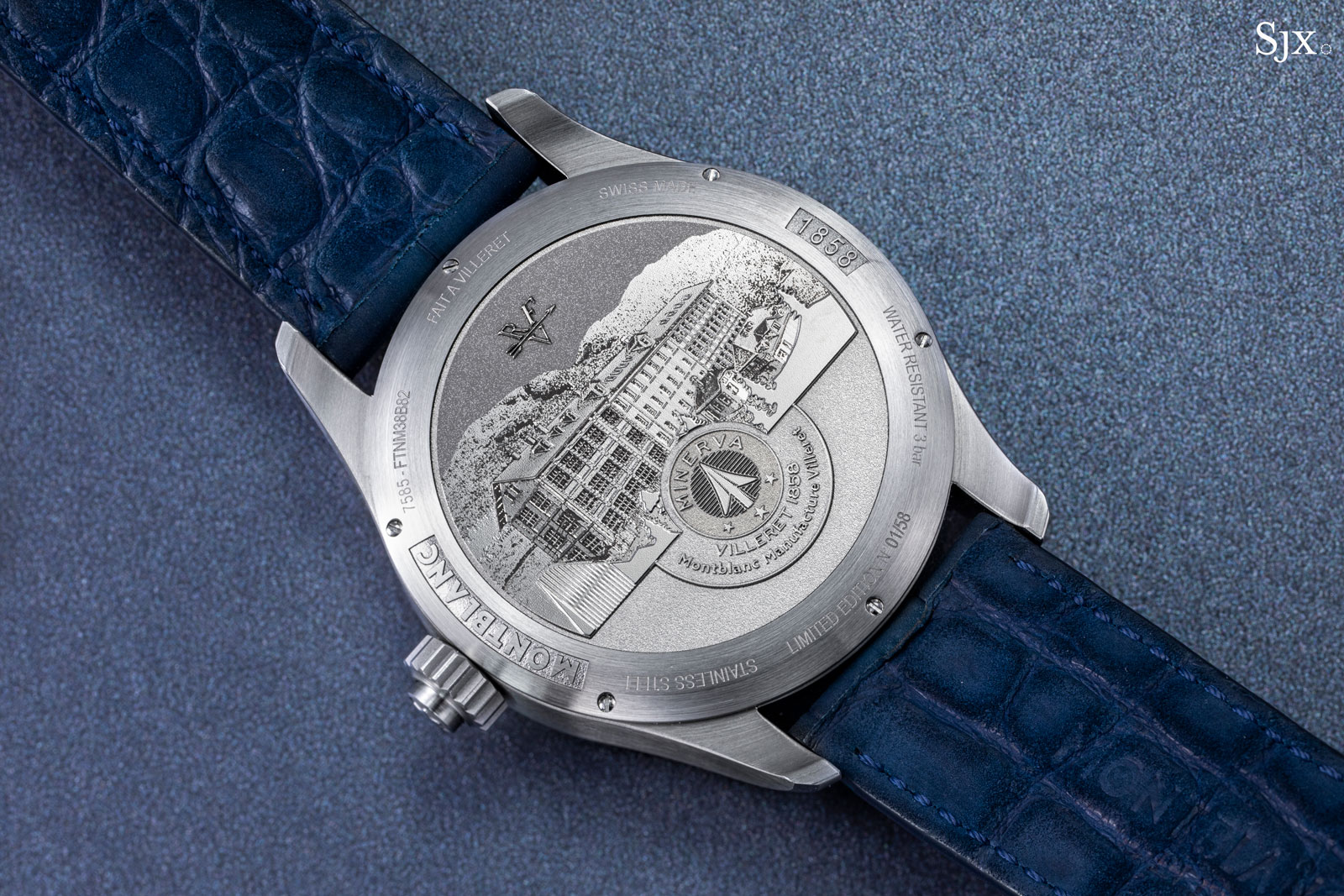
What is usually the dial side of the movement is now hidden behind a closed back bearing a relief of the Minerva factory in Villeret
The Minerva origins
Montblanc’s parent, Richemont, added Minerva to its portfolio of brands, which include Cartier, IWC, and Panerai, in 2006. The Swiss luxury group then decided to bestow the maker of chronographs upon Montblanc. That instantly gave the Hamburg-based pen maker a substantial degree of watchmaking knowhow, all of which was concentrated in the Minerva workshop in Villeret, a town that was also once the home of Blancpain.
Minerva was historically a maker of stopwatches and chronographs that were good quality and workmanlike, but far from being as elaborate as its movements are today. The transition from workmanlike to haute horlogerie occurred under the brand’s prior owner, an Italian businessman who liked watches.

The Minerva manufacture in Villeret
Montblanc now continues Minerva’s high-end watchmaking, though the Montblanc brand has yet to become synonymous with fine watchmaking. But that doesn’t take away from the watches themselves, which are varied and impressive. Montblanc has unveiled dozens of Minerva-powered models to date, all of which are finely finished and most of which are very large due to the pocket-watch origins of Minerva’s movements.
The complication most representative of fine watchmaking at Minerva, and by extension Montblanc, is the chronograph. And because of Minerva’s historical focus on the complication, the Montblanc chronograph collection is wide ranging in terms of size and specifics.
Over the last decade Montblanc rolled out a variety of Minerva movements, ranging from a split-second chronograph to a 1/100th-of-a-second chronograph with twin balance wheels, though it now mostly focuses on a smaller number of less exotic calibres.
But less exotic by Minerva standards is still a fine, high-end chronograph. Its simplest movements are both mono-pusher chronographs in two sizes, with the larger calibre having the button integrated into the crown (which is the base for the Unveiled Secret) and the smaller movement having it at two o’clock.
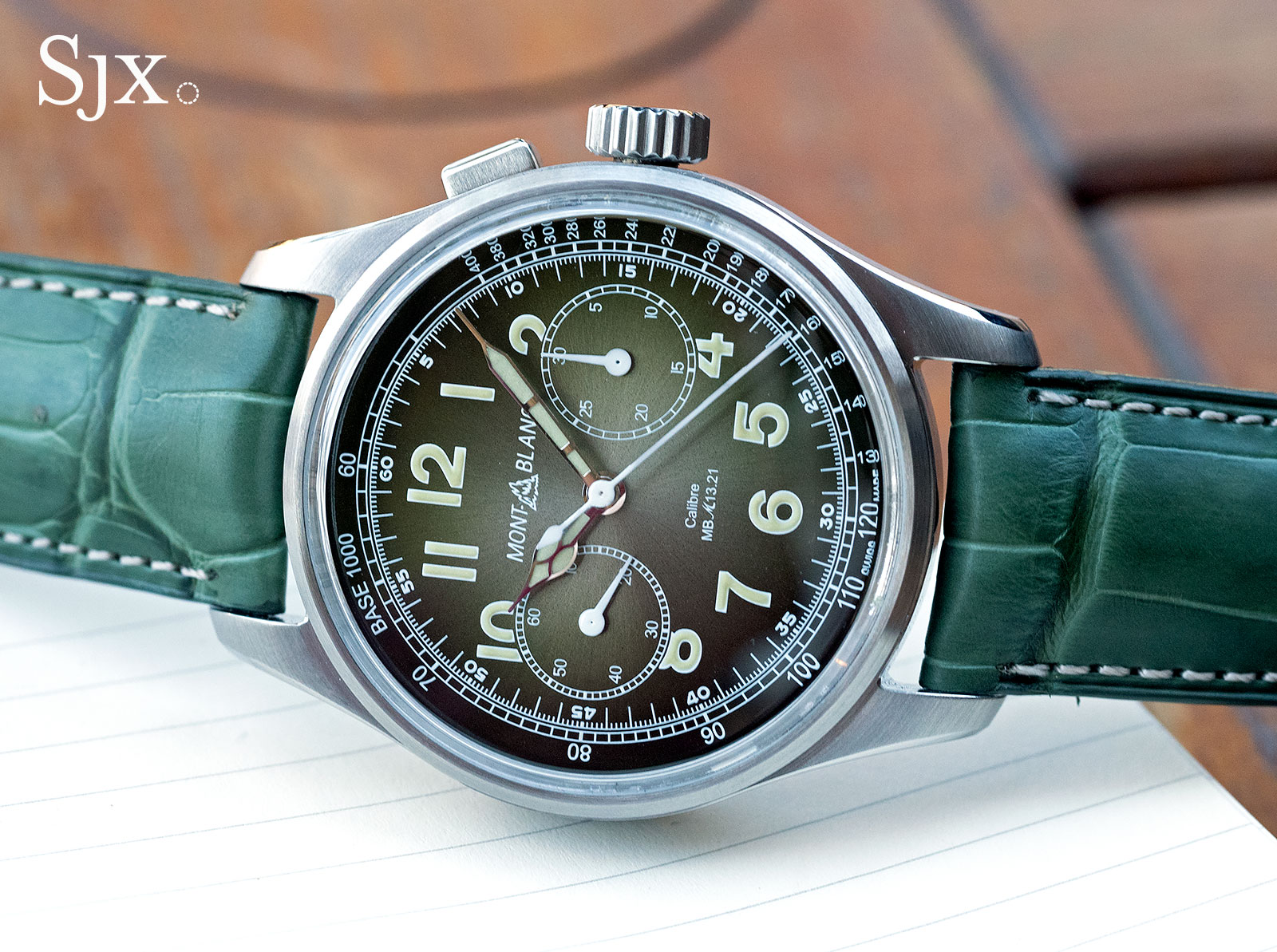
The smaller Minerva-powered Montblanc mono-pusher chronograph
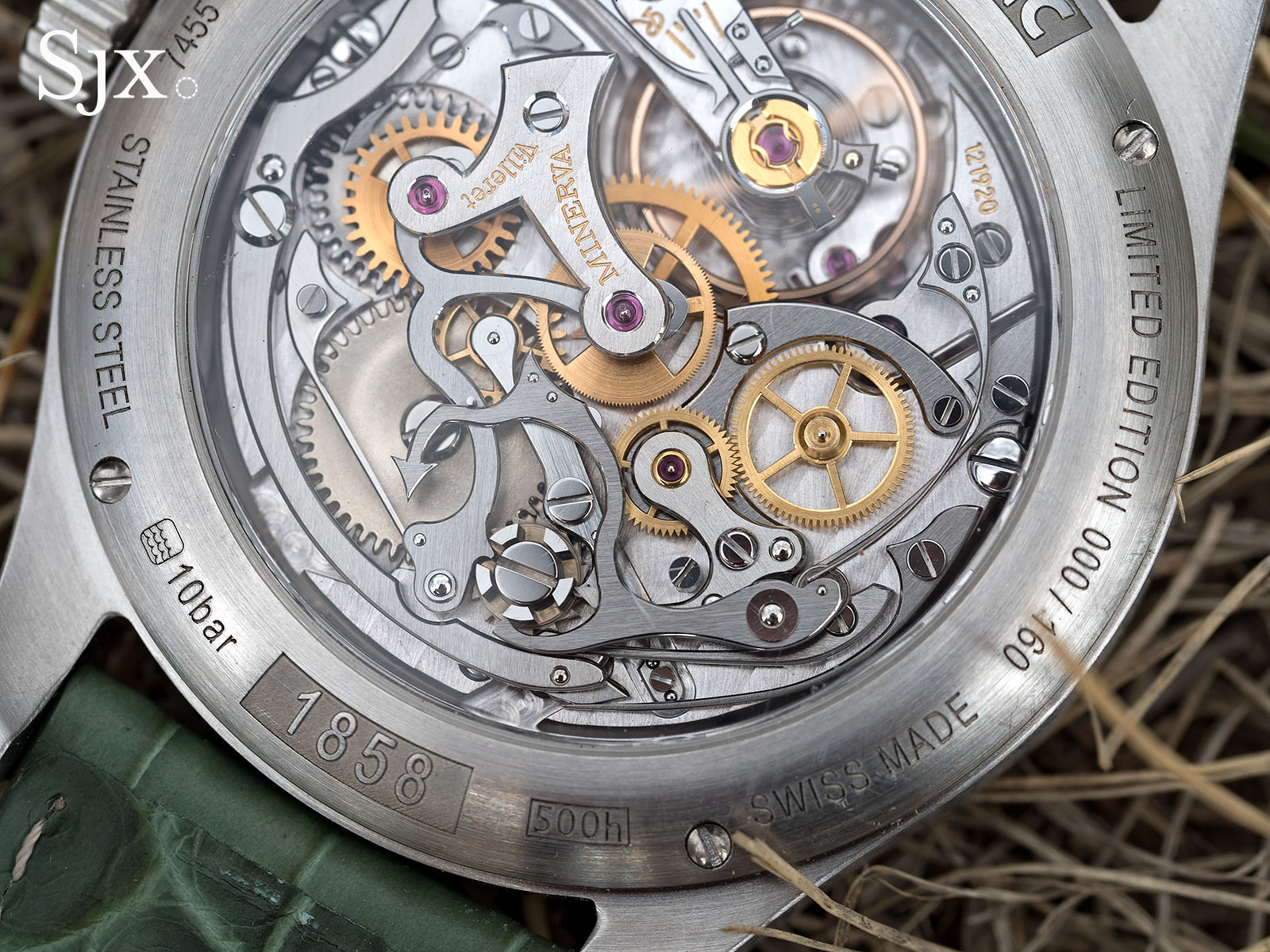
The compact MB M13.21
Although Montblanc produces the Minerva chronograph movements from scratch today – they are not “new old stock movements” – the calibres are essentially vintage movements in terms of architecture. They have been refined and modified to optimise function and production, but they remain old fashioned calibres at heart, explaining the traditional layout.
In addition to the old-school looks, the Minerva movements are enhanced by fine finishing that ranks amongst the best. While different in style to most comparables, the decoration is arguably as good as that of industry benchmarks like A. Lange & Söhne.
Turning things around
As with past models, the Unveiled Secret is similarly powered by a historical movement, but one that’s been modified to accommodate the inversion. Specifically, the movement is the MB M16.26, which is the inverted version of the MB M16.29. Instead of hiding the beautifully finished components of the movement, it presents everything on the front.
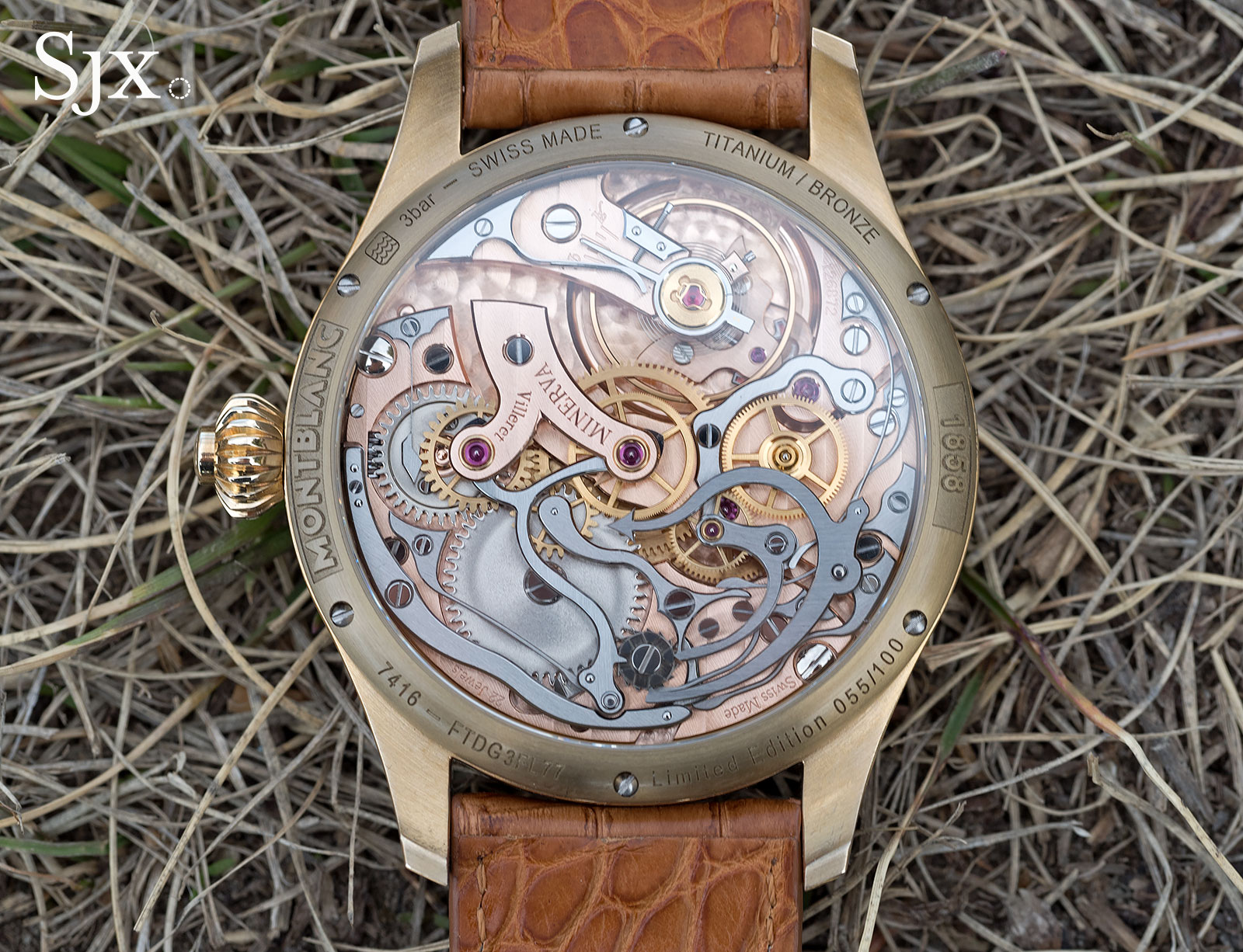
The un-inverted version of the movement, the MB M16.29
Crucially, it’s worth mentioning again that that the movement in the Unveiled Secret is not the result of adding a module on the dial side of the movement. Amongst the telltale signs that it’s an integrated calibre is the large, slow-beat balance wheel visible on the dial. Instead, the MB M16.26 is an integrated chronograph movement has been arranged back to front, allowing the owner to wear the movement side as the dial.
Inverting the movement is novel in terms of aesthetics, but also brings with it a few technical challenges since the hands now have to be repositioned from one face to another.
But it is not merely a matter of installing hands on a cannon pinion that’s been extended on the movement side. In fact, it is physically impossible to extend the shafts that carry the hour and minute hands, since the chronograph seconds wheel gets in the way. For the same reason, the only hand that can be directly mounted on the inverse face is the central seconds hand for the chronograph (since its driving wheel is already there in the centre).
Consequently, several auxiliary wheels are needed to relocate the hours and minutes away from the what is conventionally the dial side. This moves them both vertically as well as laterally, tracing a path that bypasses the centre of the movement. All that explains the half dozen or so gilded gears visible below the open-worked rings on the front, which are part of the redesigned motion works and therefore not seen on conventional, un-inverted chronograph movements.
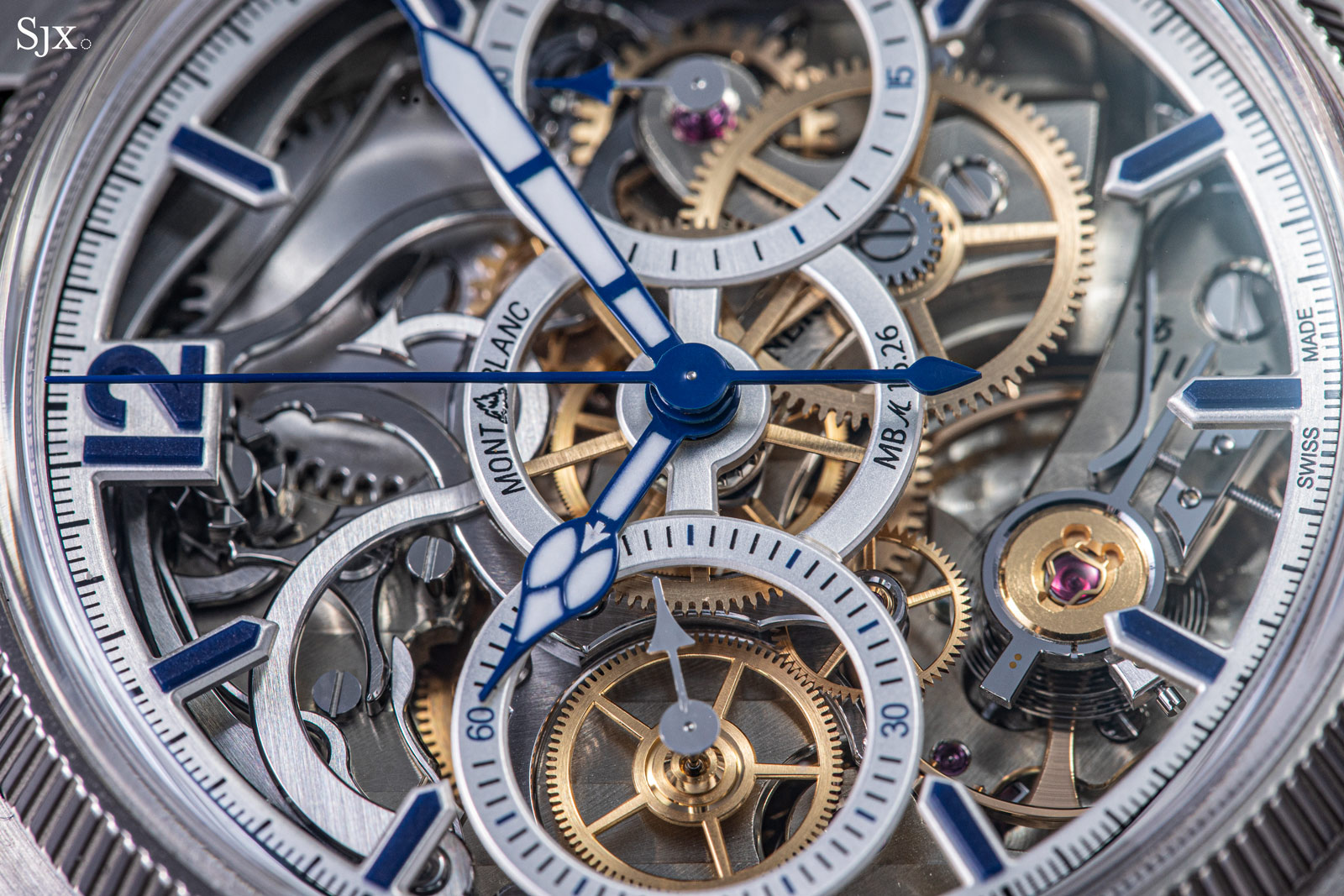
The chronograph seconds hand is directly mounted on what is usually the back, which is now the front on the Unveiled Secret
But that’s not all. Simply relocated the hands to the movement side will result in them going counter-clockwise, because the second and fourth wheels rotate counter-clockwise when seen from the movement side. In a conventional movement, that means the minute and hour hands move in the opposite – and clockwise – direction when seen from the front.
Although Montblanc didn’t provide specifics of the setup, the solution becomes evident upon closer inspection – the entire going train is made to run in the opposite direction compared to convention, as evidenced by the escape wheel that is mounted in the opposite direction. This ensures the hands all rotate in the correct direction – the seconds hand for instance, is driven by the extended pivot of the fourth wheel, which now runs clockwise when viewed from the dial side.
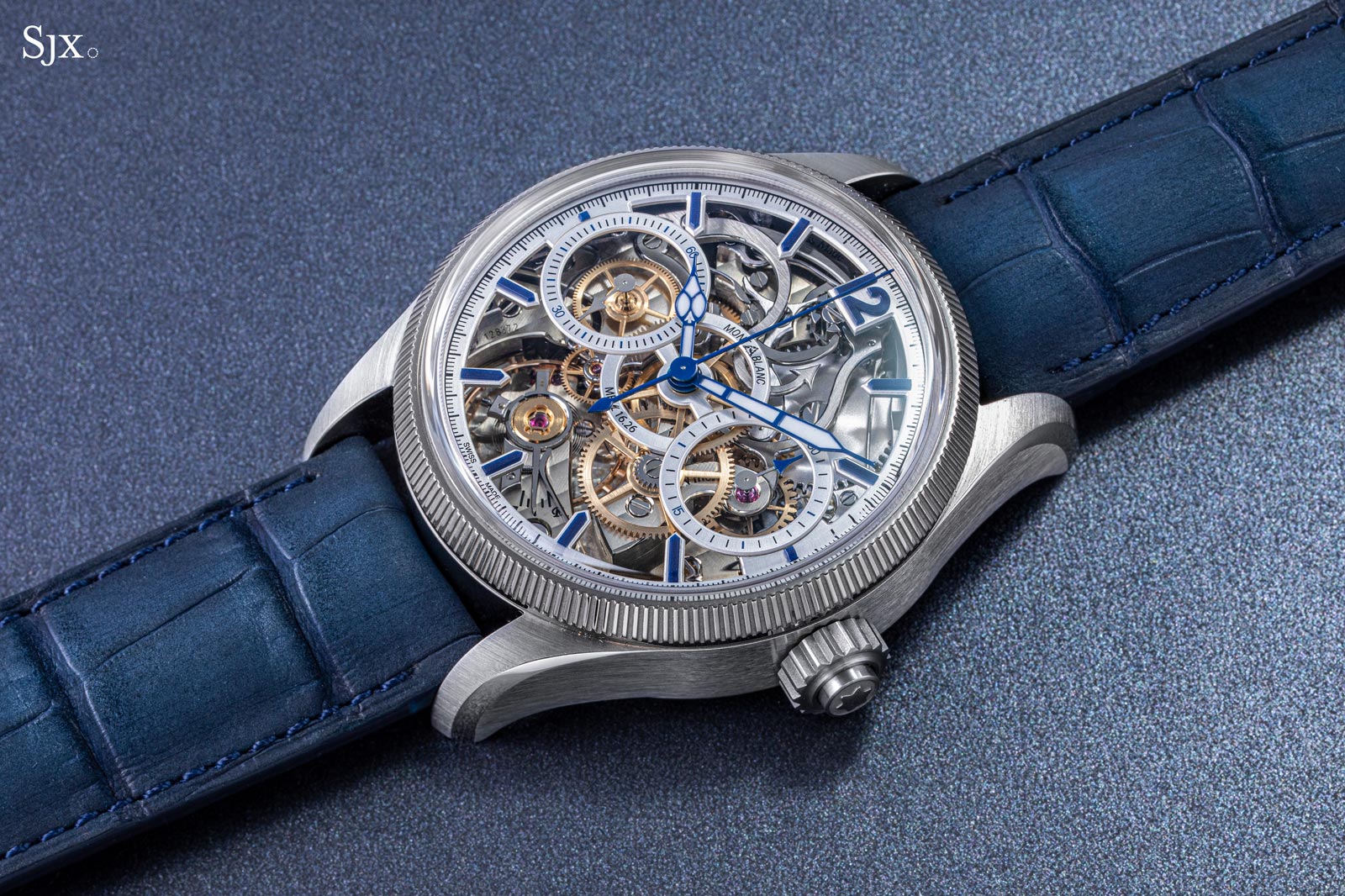
A mono-pusher with a twist
Since the movement now runs backwards, the barrel also has to be wound in the opposite direction. This requires an intermediate wheel between the ratchet wheel and crown wheel of the winding train to reverse the direction of wind. As a result, turning the crown as usual still winds the mainspring, even though the mainspring itself is being wound in the opposite direction from convention.
Meanwhile, the keyless works that facilitate winding and time setting are essentially similar to that in the standard movement, with one key difference: a slipping clutch replaces the conventional cannon pinion, allowing the minute and hour hands to be adjusted through the auxiliary gear train.
At the same time, the keyless works are now hidden behind the solid case back since they would ordinarily be under the dial in a normal watch. This distinguishes the Unveiled Secret from a regular open-worked movement, which typically reveals the time-setting mechanism at the three o’clock position.
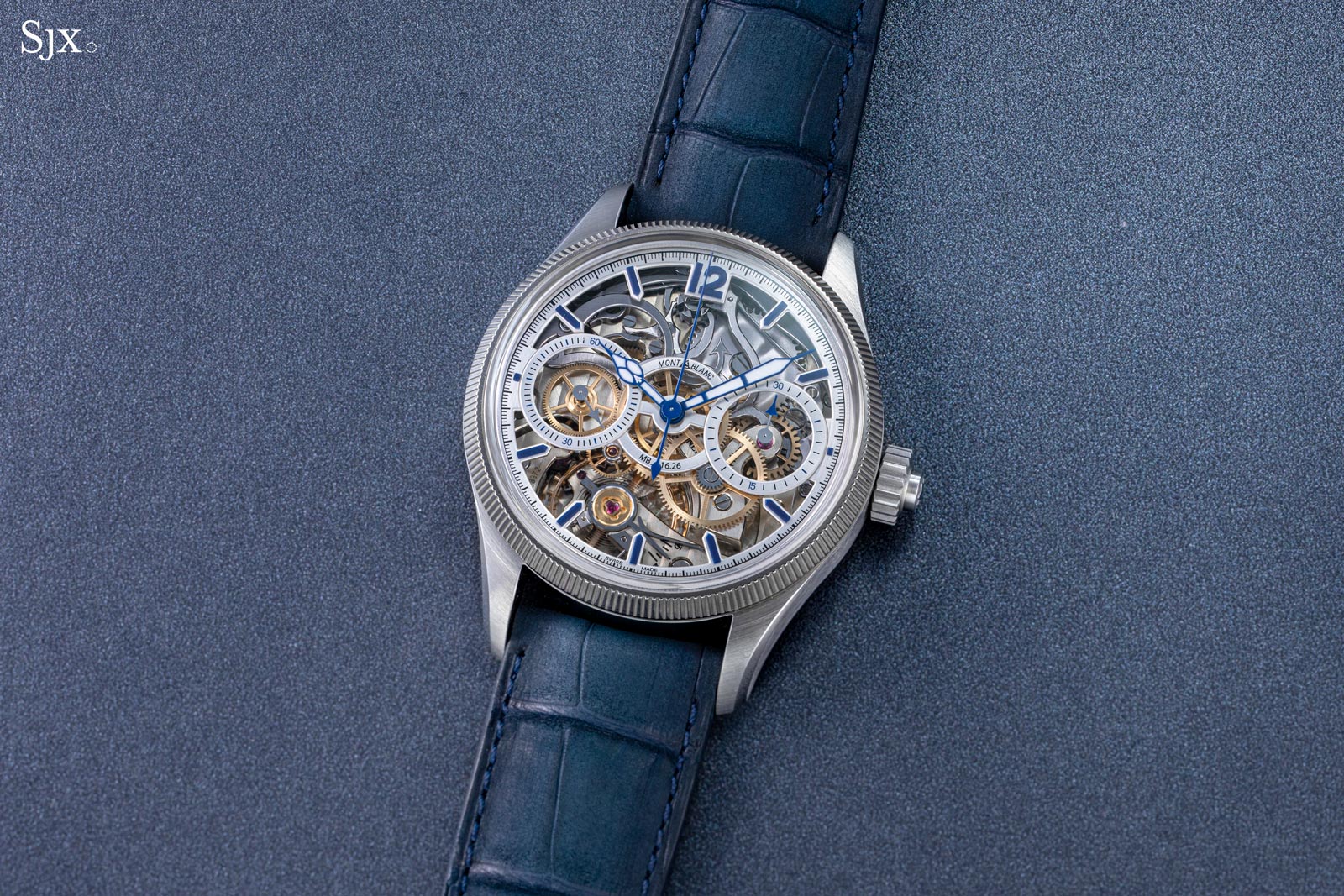
Movement finishing
Because the movement is inverted, its details can be enjoyed while the Unveiled Secret is on the wrist. That is the point of the whole exercise, simply because the MB M16.26 is an attractive movement. Its allure stems from three features: rich colours, traditional construction, and excellent finishing.
To start with, the movement made up of bridges in German silver, steel levers, as well as gilded brass wheels. They complement and contrast with each other, providing a vivid canvas even without finer decoration. It’s a good enough combination that Lange and Voutilainen rely on the same materials in their movements.
The next element that makes the movement what it is are the chronograph levers and bridges, all of which are classical in form. The steel chronograph levers, for instance, are narrow but tall, giving the movement depth and lending it a high-end appearance. And the levers also incorporate flourishes, most obvious in the form of the arrowhead at the end of one. Nicknamed “devil’s tail”, this is found in all Minerva movements and is a nod to the brand’s historical arrowhead emblem. All that contrast with more affordable chronographs like the Speedmaster Professional powered by the Lemania derived cal. 3861, which has flat and wide levers that are simpler in form.
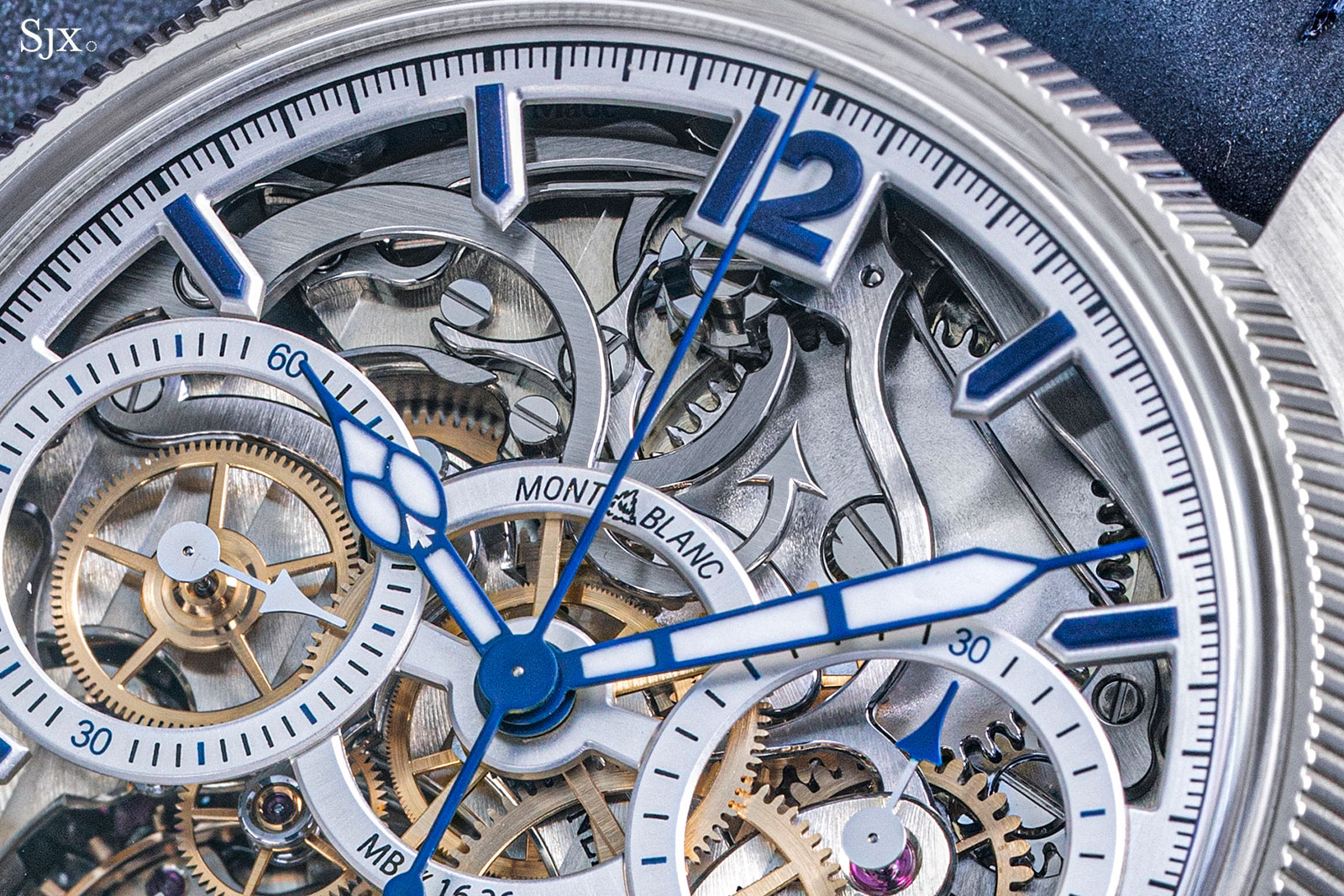
And the movement’s final point of appeal is its finishing, which good enough to equal or even surpass establishment, haute horlogerie brands.
The bridges and levers sport wide bevelling that’s rounded and mirror polished, while also incorporating inward and outward angles executed with sharp definition. The countersinks are similarly finely finished – they are wide and bowl-shaped with polished surfaces.
Other attractive elements include the swan’s neck regulator that’s entirely black polished on its top and bevelled on its edges. The swan’s neck regulator itself is a retro detail that reveals the age of the movement, since most high-end modern movements are instead equipped with a free-sprung balance.
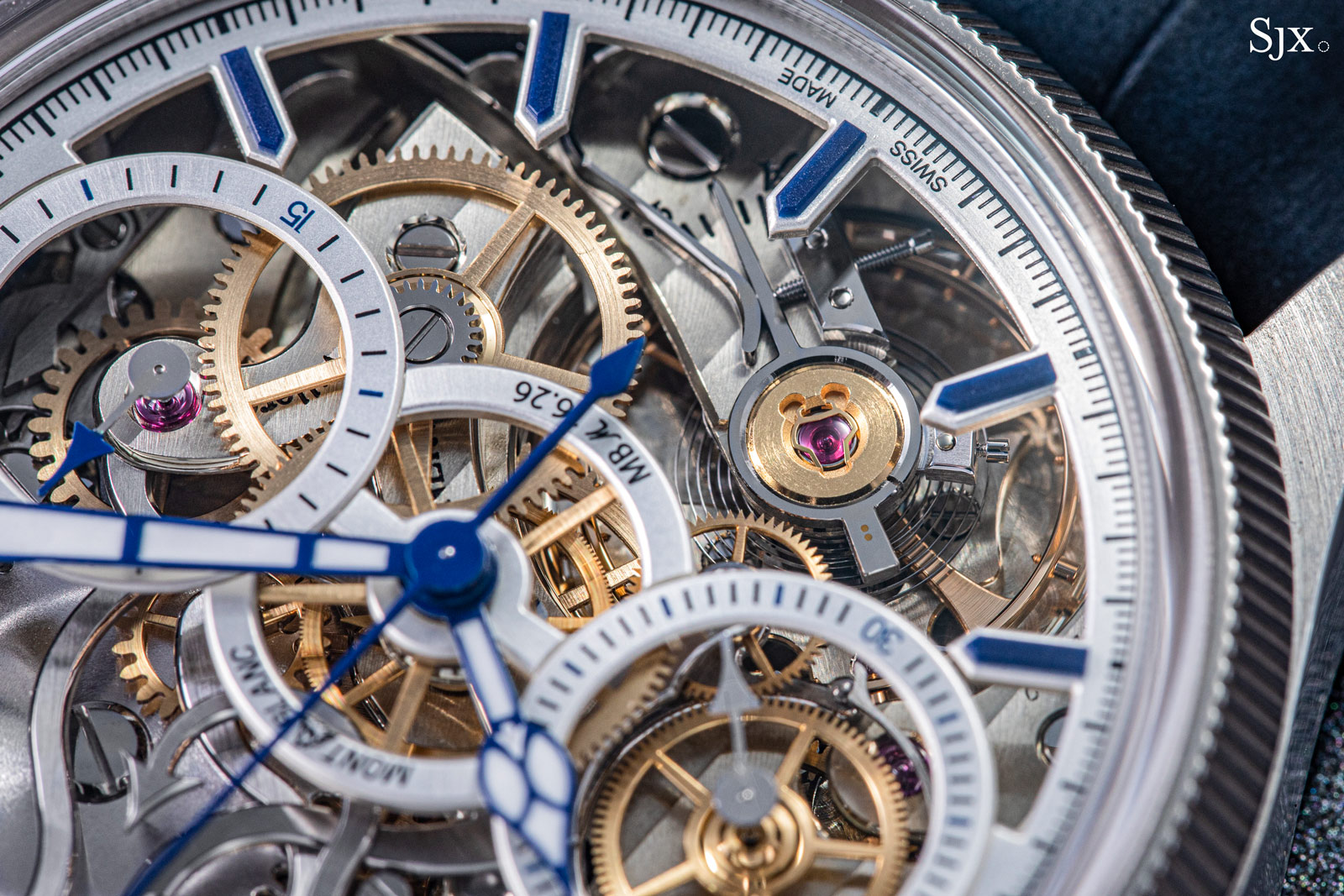
The swan’s neck regulator on the balance cock between five and seven o’clock
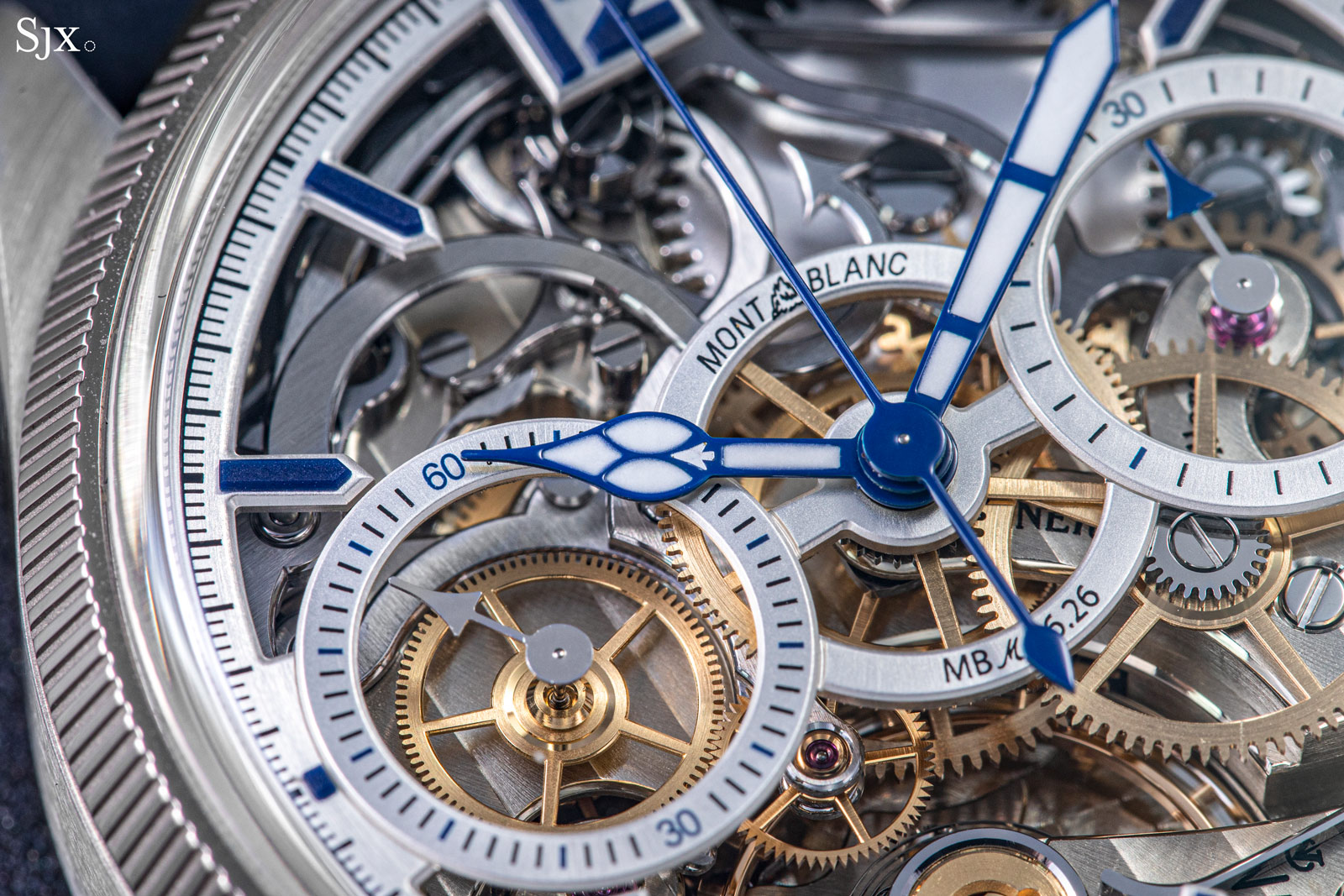
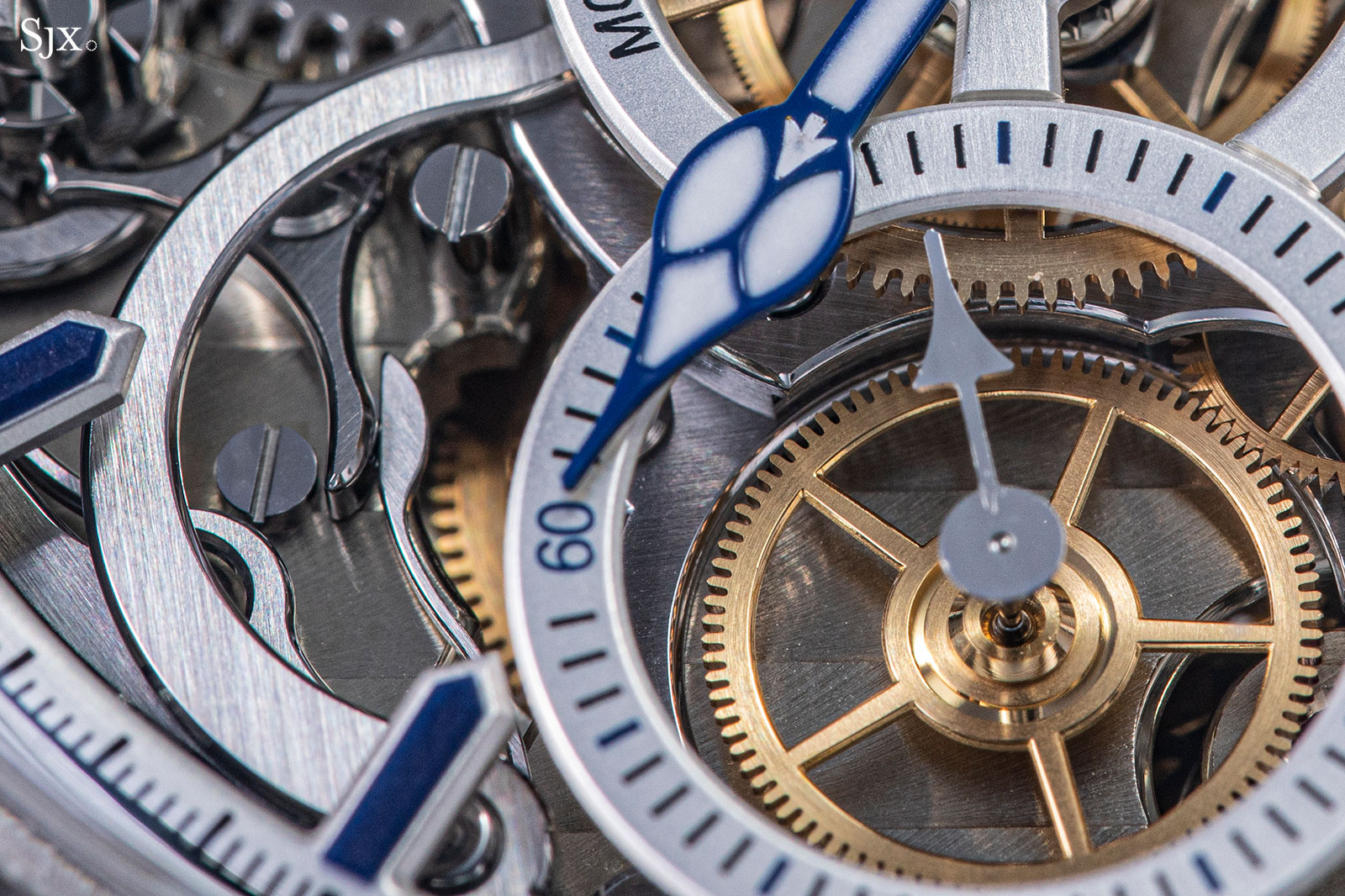
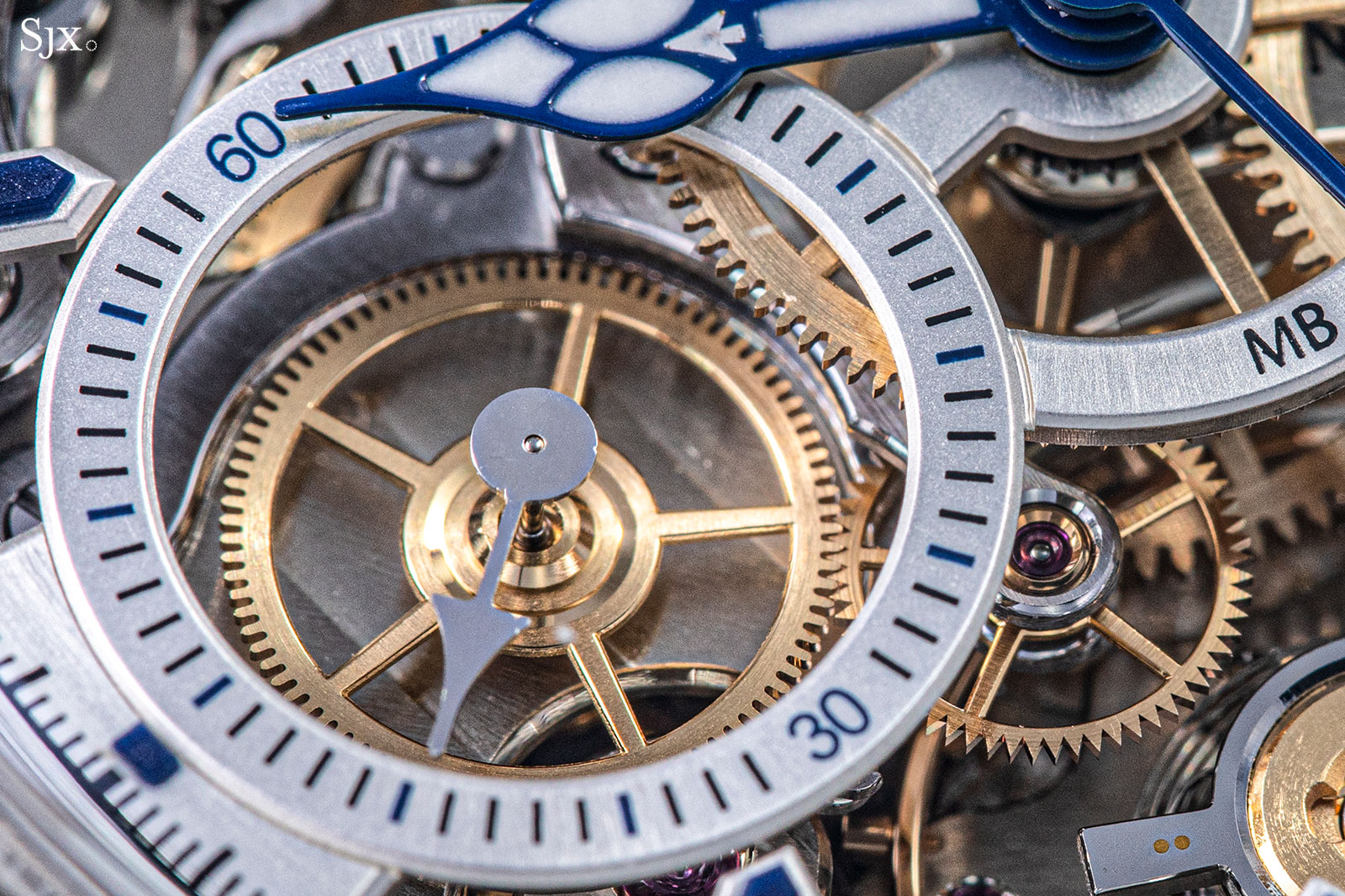
The wheel that drives the running seconds exemplifies the impressive finishing of the movement – it sports several planes of polished and brushed surfaces around its centre
The traditional aesthetic puts this calibre in the same class as other traditionally constructed chronographs such as the Datograph, although the MB M16.26 falls behind in terms of modern amenities and technical innovation due to its age.
It looks like a classical chronograph movement from the early to mid-20th century because it actually is. The MB M16.26 and its related movements originate with the 17”’ movement that Minerva developed in the first two decades of the last century, so in some ways the Unveiled Secret and other Minerva chronographs are reissues of the vintage originals.
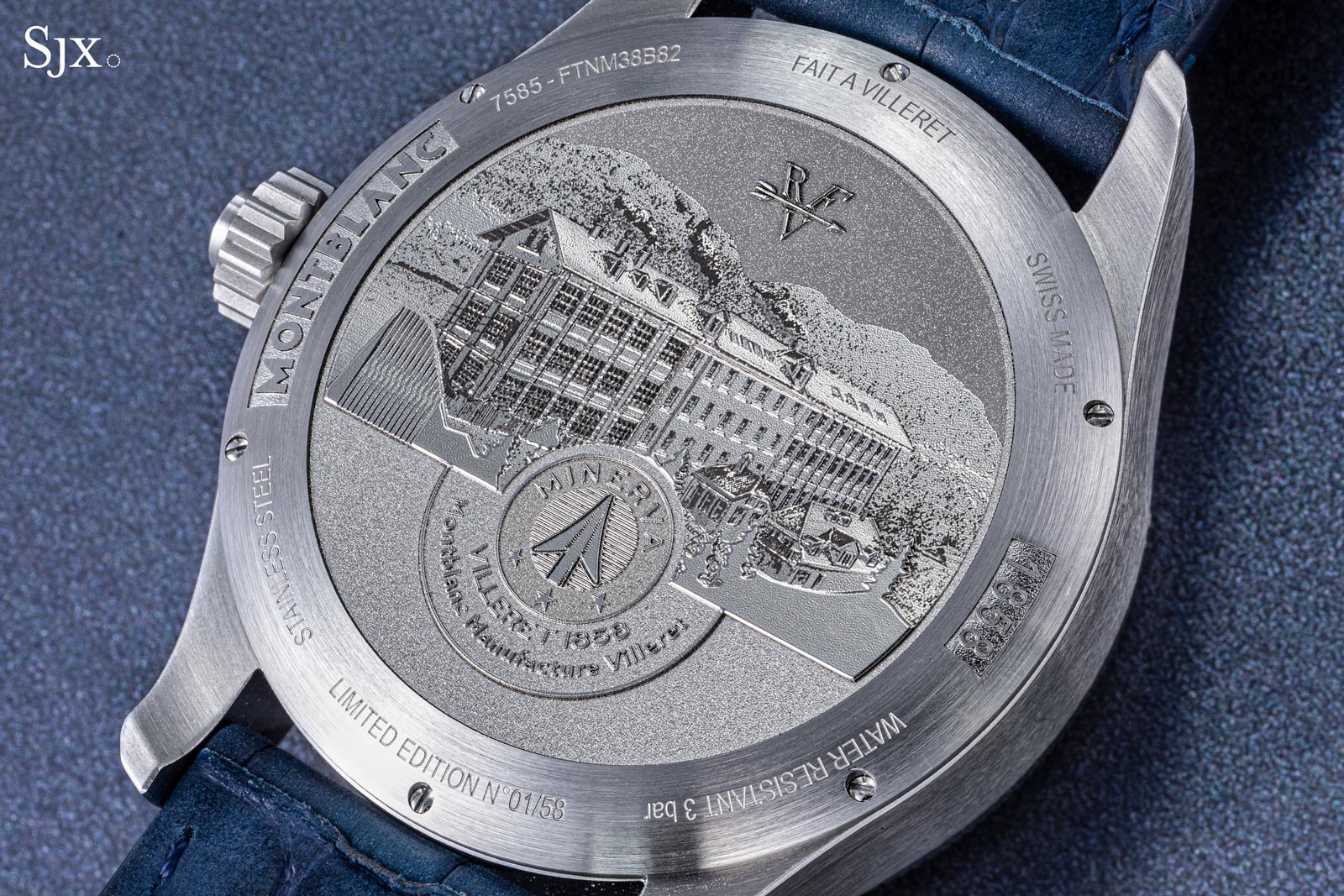
The reverse of the movement is hidden but will no doubt be as well finished as the front
Case and dial
The movement sets a high bar in terms of quality, which unfortunately means the case and dial of the Unveiled Secret are less impressive by comparison. They are passable, but lack the thoughtful, high-quality fit and finish of the movement. Admittedly, that is not entirely a fair criticism given the price of the Unveiled Secret, but the disparity between them is apparent.
The case is straightforward in its construction. It has tall, vertical flanks, leaving the case looking plain and chunky, a look that only works with affordable, robust sports watches such as the Tudor Black Bay. In fact, the movement is already thick and the case makes no effort to disguise that, which means the Unveiled Secret looks as thick as it actually is, which is a bit over 14 mm.
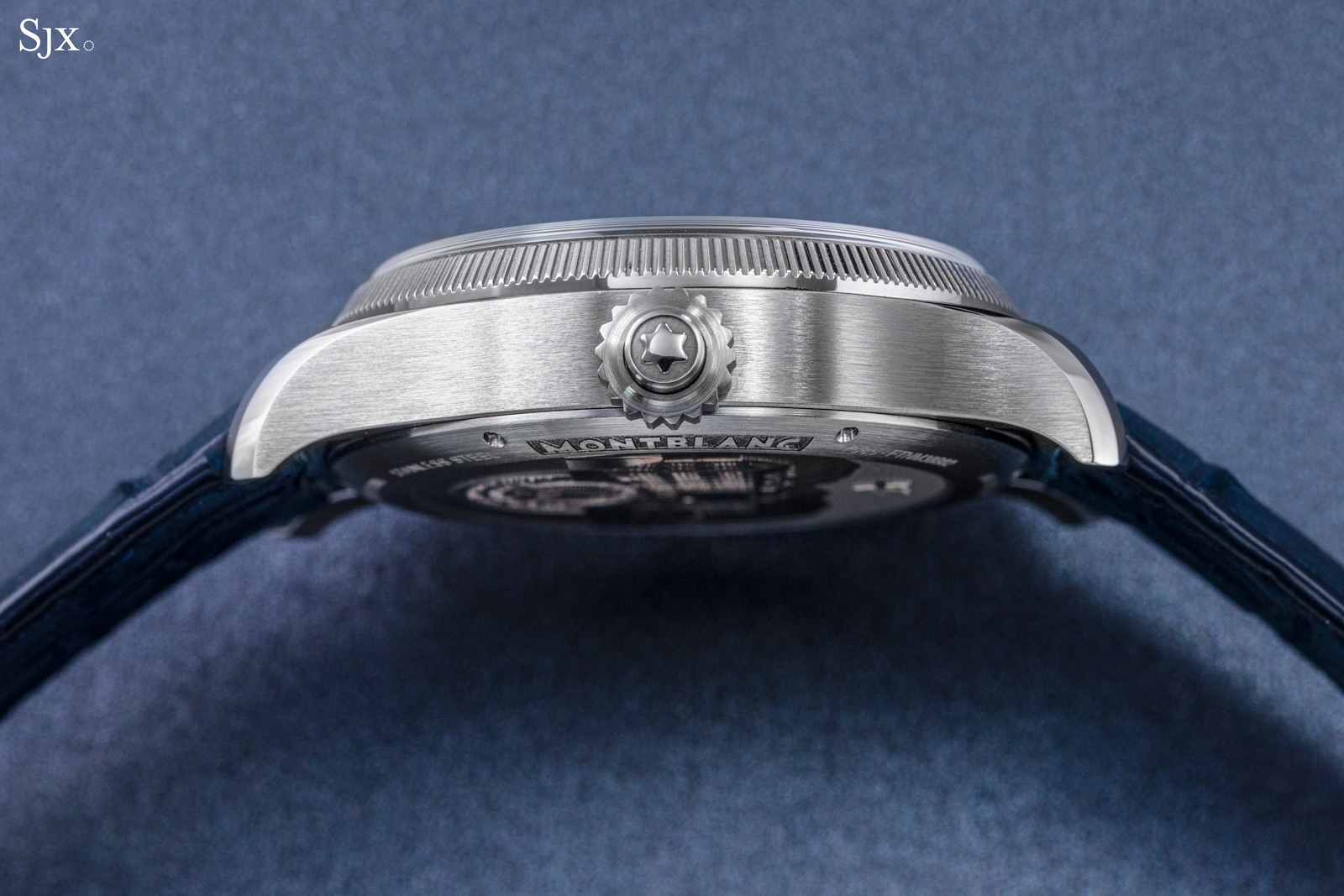
The details of the case are likewise plainly executed. The flutes of the bezel, for instance, lack the sharp definition found on bezels by Rolex or Parmigiani. That said, the polished bevel along the top edge of each lug gives the case a bit of refinement.
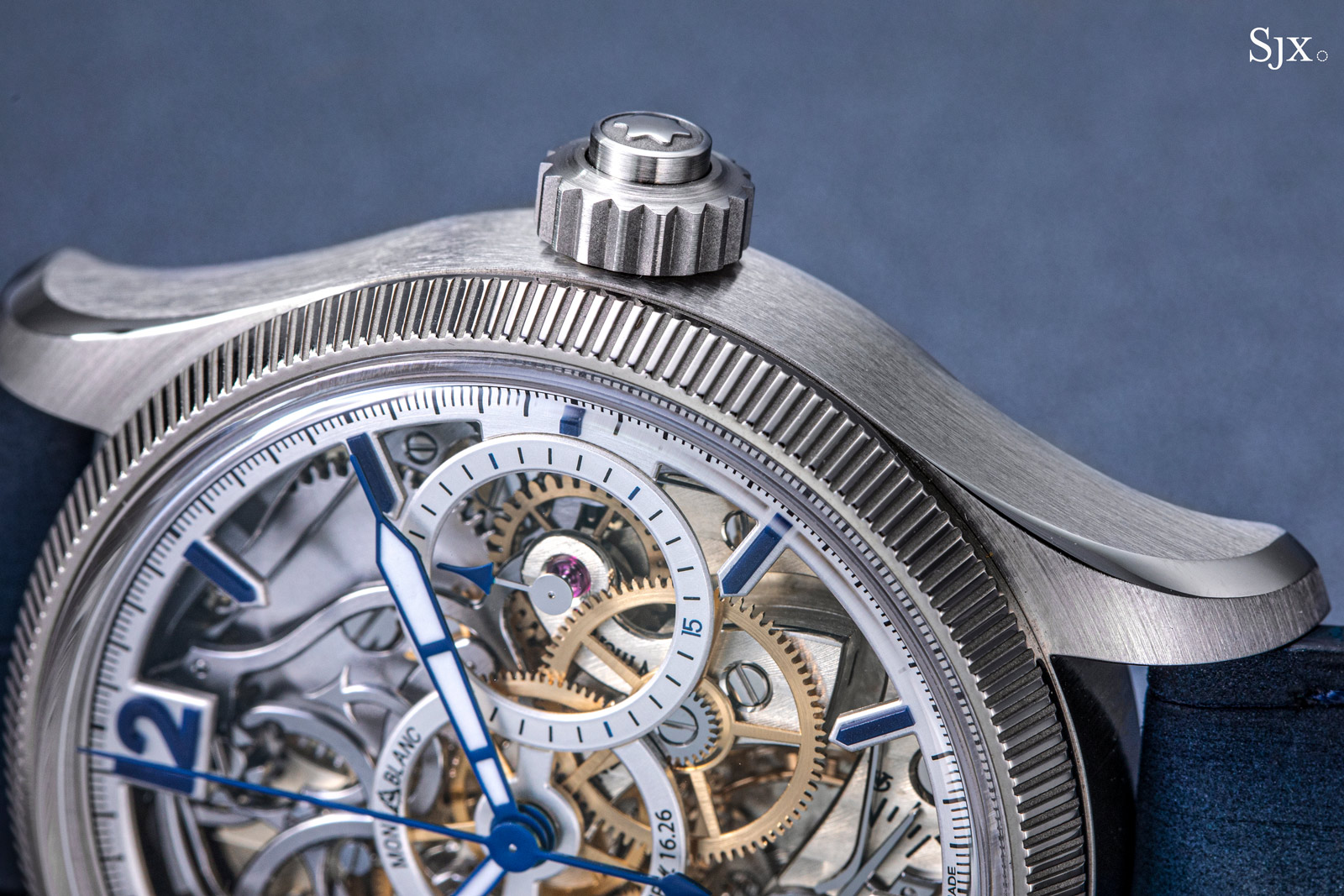
The Unveiled Secret has no dial to speak out, save for the rings that carry the hour markers and chronograph registers. Despite their width and the fact that they are silver, the rings are prominent thanks to their blue markings. The blue markings are a bit much and take too much attention away from the movement. In contrast, the gold version of the Unveiled Secret has a more subtle dial.
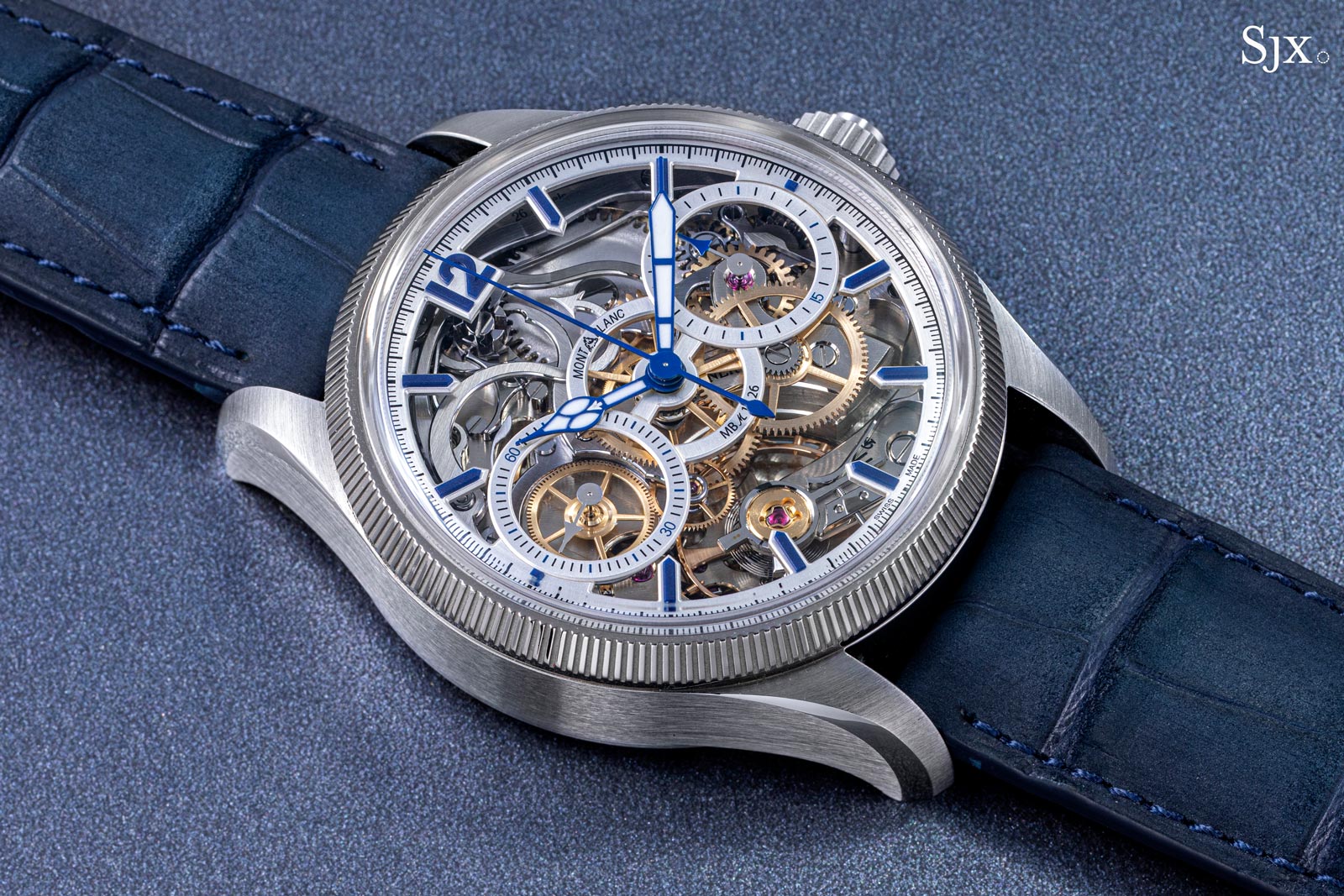
In fact, the rings are surprisingly obvious, making them a focal point of the dial. That isn’t exactly a good thing because the fit and finish of the rings are merely adequate. The rings are clearly stamped, resulting in the soft edges that contrast with the sharp finishing on the movement parts.
While the rings may be a seemingly unimportant detail given the Unveiled Secret is all about the movement, the dial does matter. It is apparent enough that the disparity between the rings and movement is noticeable. The specifics of the dial finish are not visible except under magnification, but the even at arm’s length it is clearly finished different from the movement.
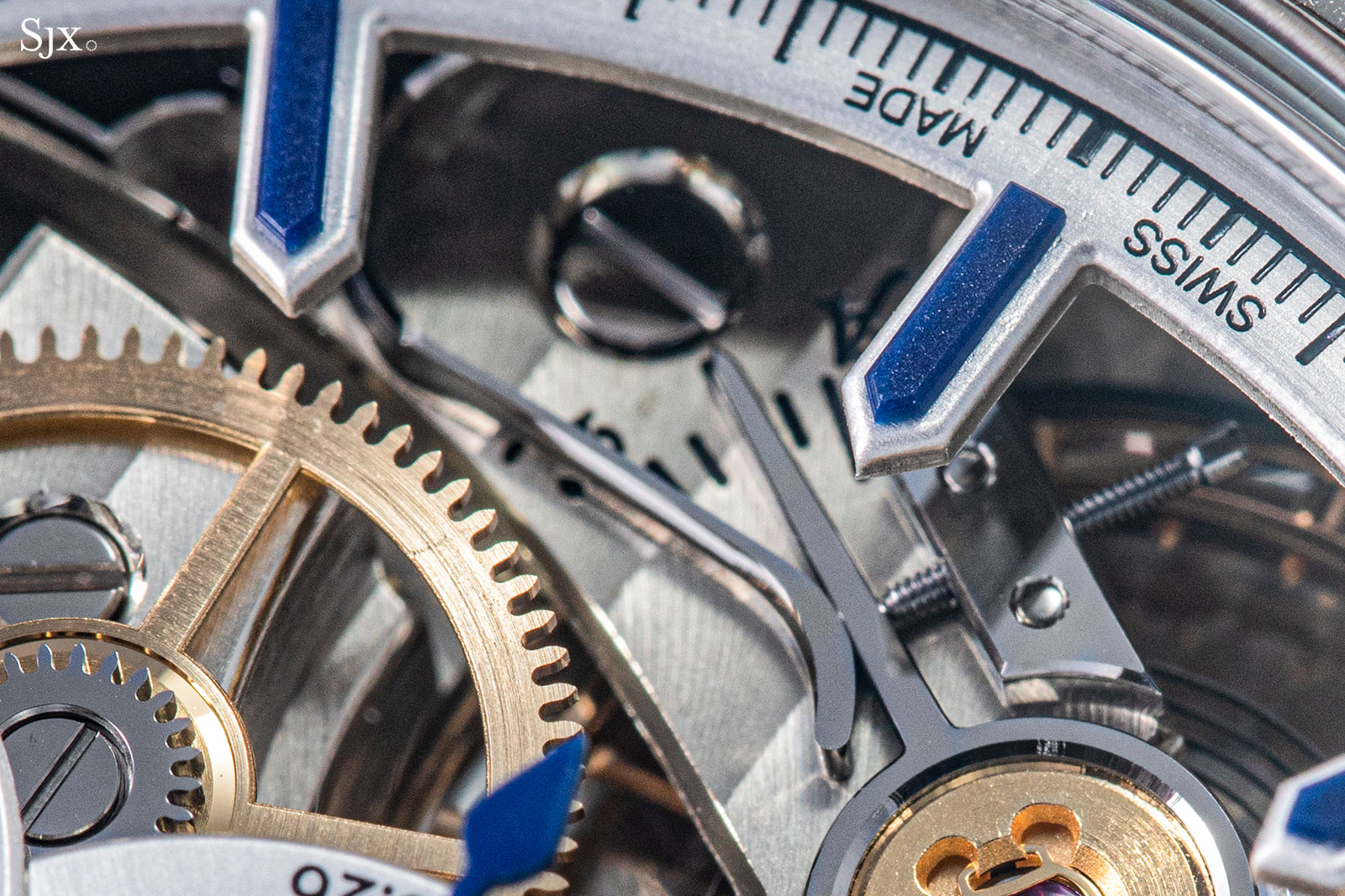
The blue hour markers appear to be resin appliqués that don’t look too good up close
Conclusion
Like its compatriots with Minerva-based movements, the Unveiled Secret is an attractive watch because of the wonderfully executed movement. But it is more interesting than past models because the movement is inverted, allowing the watch to be worn back-to-front, which puts on show the excellent, excellent finish. The appeal does come with has a few caveats, namely the middling execution of the dial and case.
More broadly, the Unveiled Secret demonstrates that Montblanc is not merely reusing the same movements every year with different cases and dials. The movement in the Unveiled Secret is a meaningful reworking of the original calibre that hopefully indicates the shape of things to come.
It might be a stretch, but perhaps Montblanc will eventually embark on something more ambitious, such as an all-new movement to replace the decades-old Minerva calibres that were first conceived for pocket watches. Until then the Unveiled Secret will do as the most novel Minerva-powered Montblanc in the catalogue.
Key facts and price
Montblanc 1858 The Unveiled Secret Minerva Monopusher Chronograph
Ref. 129622 (Lime Gold)
Ref. 129613 (steel)
Diameter: 43 mm
Height: 14.18 mm
Material: 18k Lime Gold or steel
Crystal: Sapphire
Water resistance: 30 m
Movement: MB M16.26
Functions: Hours, minute, seconds, and chronograph
Frequency: 18,000 beats per hour (2.5 Hz)
Winding: Hand wind
Power reserve: 50 hours
Strap: Alligator with pin buckle
Limited edition: 18 pieces in Lime Gold and 58 pieces in steel
Availability: From Montblanc boutiques and retailers
Price:
Lime Gold – US$48,000, or 69,000 Singapore dollars
Steel – US$33,500, or 48,500 Singapore dollars
For more, visit montblanc.com.
Amendment June 23, 2022: Updated explanation of the inverted movement.
Back to top.
